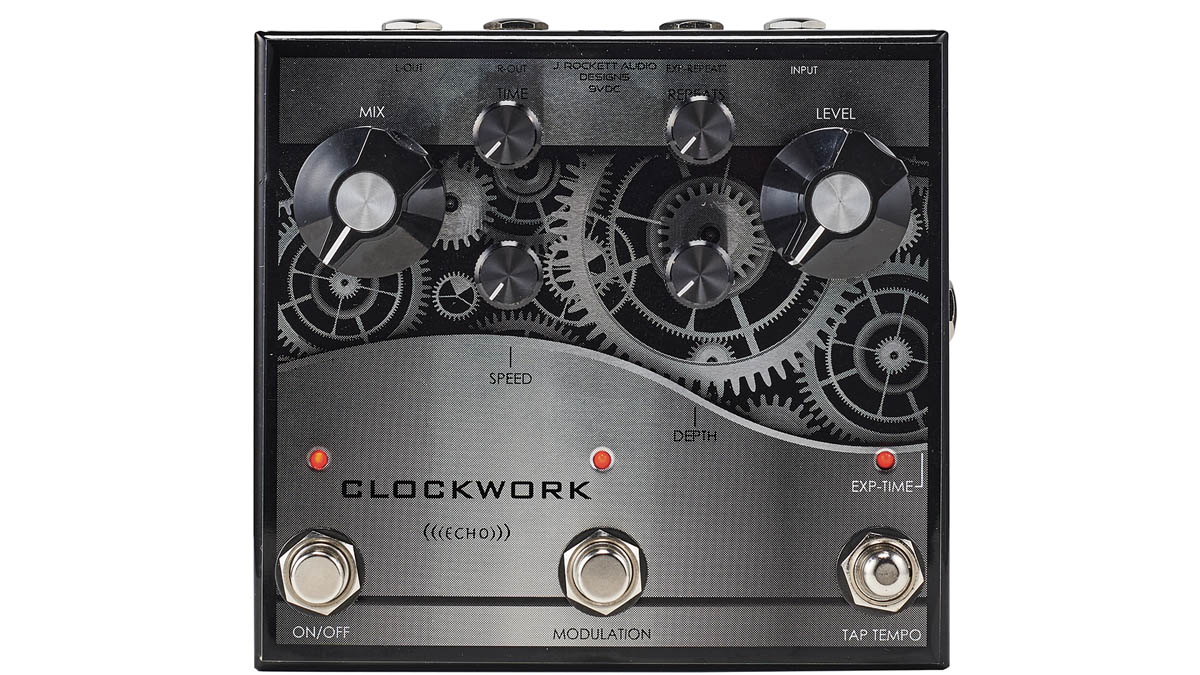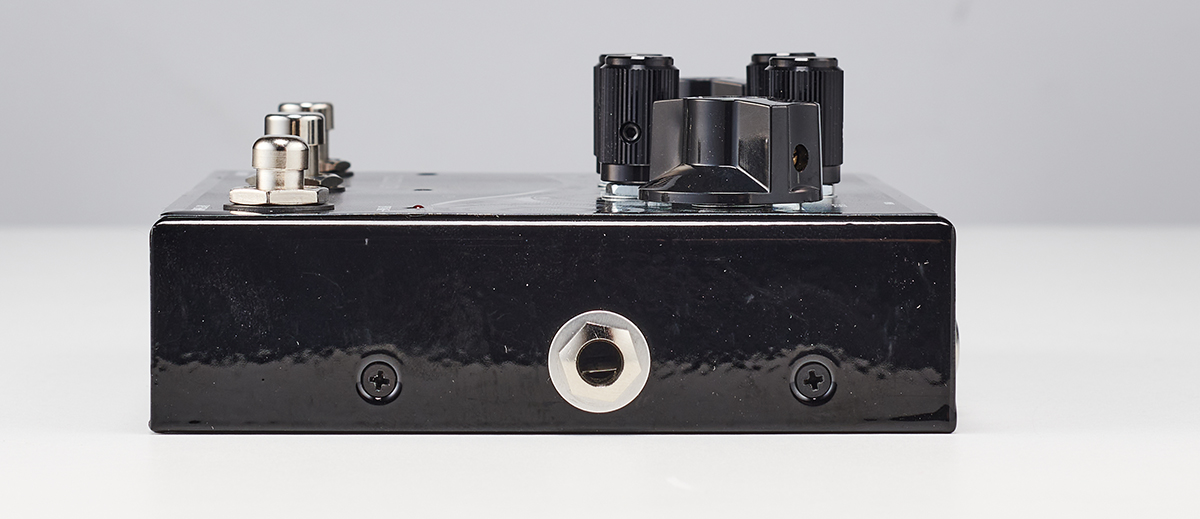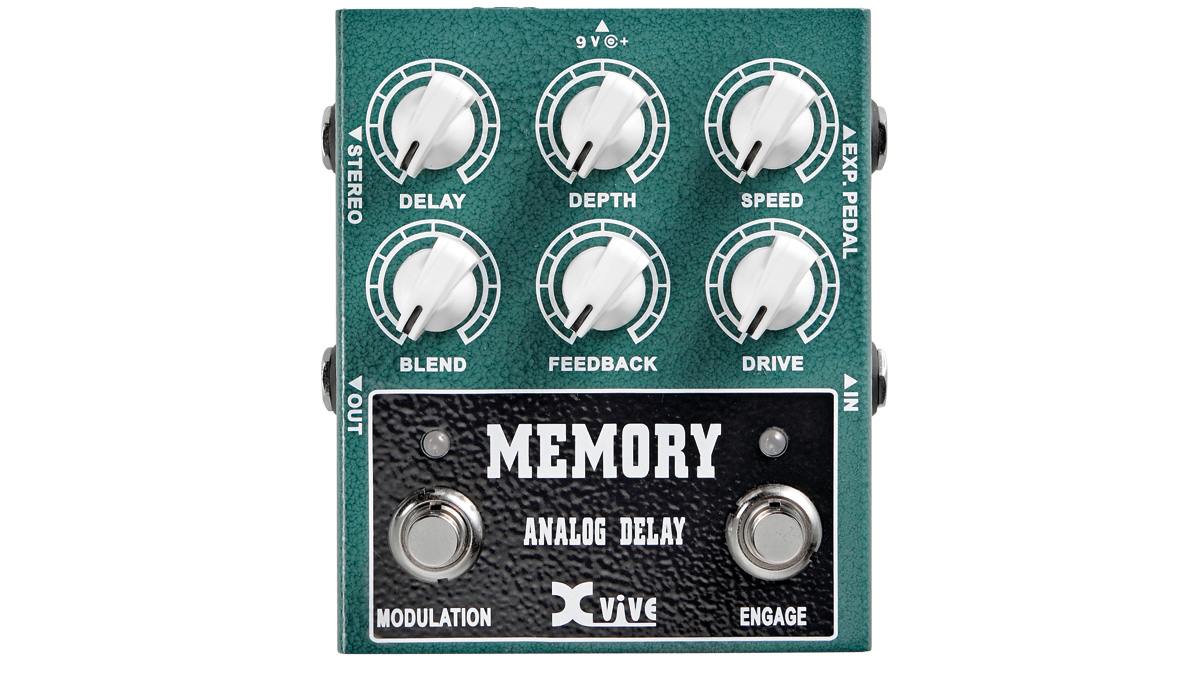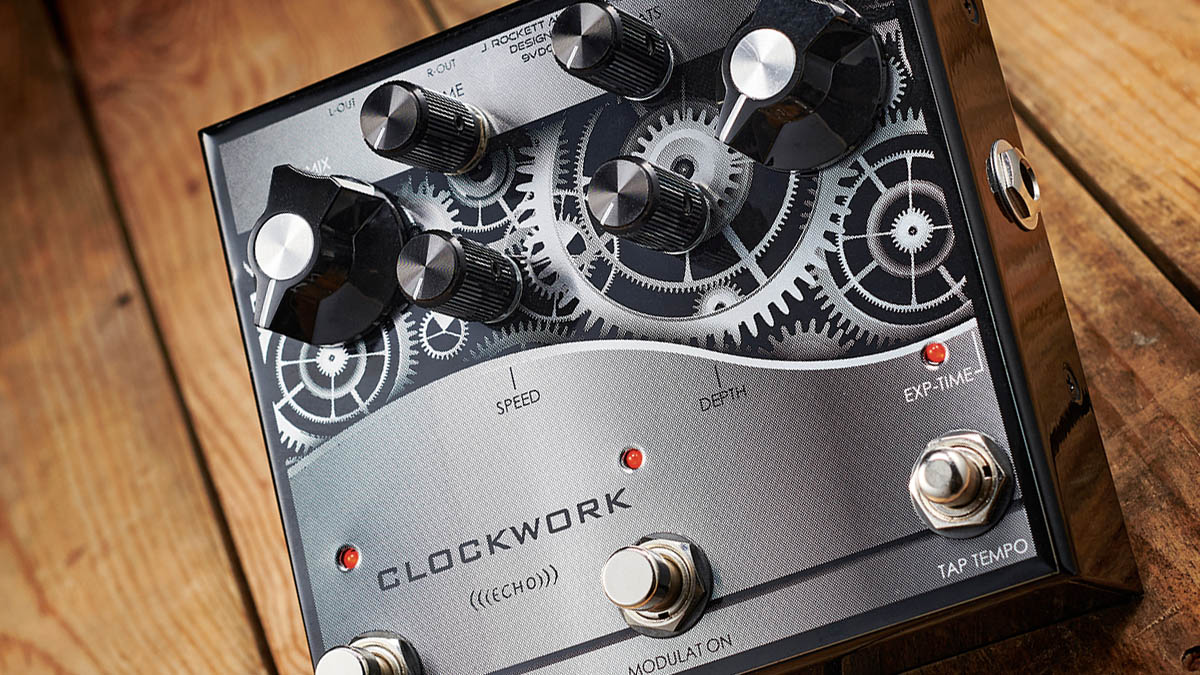MusicRadar Verdict
The Clockwork Echo does a neat job in presenting the analogue magic of classic bucket brigade delay and modulation in a more functional format, with longer delay times expanding on the old Man’s repertoire.
Pros
- +
Classic bucket brigade delay sounds and analogue modulation.
- +
Better control off modulation and it's footswitchable.
- +
Tap tempo.
- +
Two expression pedal inputs.
- +
Preamp level adds a sweetening boost.
Cons
- -
Pricey.
MusicRadar's got your back
J Rockett Audio Designs Clockwork Echo: What is it?
If you have ever heard a U2 record the chances are you have heard an Electro-Harmonix Deluxe Memory Man in action. It is one of the most loved delay pedals of all time, used liberally by the Edge as U2 put together a sound, complementing analogue delay repeats with the disorientating wobble of chorus and vibrato.
There would, however, be those holding the opinion that the DMM could be improved upon, and among them, you would find J Rockett Audio Designs. Indeed, you’d find the DMM’s original designer, Howard Davis, in agreement, too, as he sat in with J Rockett for the development of the Clockwork Echo, expanding what we thought was possible from a bucket-brigade analogue delay.
What would they have wanted to change? Well, the original requires a 24V power supply, which is off-menu for many of our common-or-garden ISO power bricks. Furthermore, it was not a full stereo pedal, had no tap tempo function and its modulation was controlled by a single Chorus-Vibrato dial. The Clockwork Echo confronts these issues and then some.

A lot has gone into this. Four years of development, in fact. Under the hood there it retains the same reliance on analogue bucket brigade chips but incorporates some digital control over them to make for a more functional proposition. Measuring just over 5” wide, it’s also more respectful of your pedalboard real estate.
This runs on a regular 9V power supply with an internal voltage convertor pumping it up to 24V. There are a pair of external expression pedal inputs so you can control your repeats and delay times on the fly. Indeed, the biggest difference we see in the Clockwork Echo is the level of control it offers us over its sounds. There are three footswitches. One for turning the effect on and off, one for turning the modulation on and off, and the other for tap tempo.

There are controls for Mix, Level, Time, Repeats, Speed and Depth. The latter two have plenty of travel on them, giving you comprehensive control of the modulation. Mix controls the blend of wet and dry in your signal, while Time sets delay time and Repeats sets the feedback or number of repeats. This being an analogue delay, you can max out repeats and put the unit into self-oscillation mode, but you’ll pass through some extreme settings before you reach the nuclear option.
One cool feature is how the Level control is independent of the footswitches, applying a constant boost to your electric guitar’s signal. Indeed, you could use this just as a boost. Set the Mix knob so your signal is fully dry and let that Level control give your guitar amp’s front end something to think about. Every little helps.
Want all the hottest music and gear news, reviews, deals, features and more, direct to your inbox? Sign up here.
J Rockett Audio Designs Clockwork Echo: Performance and verdict
The Clockwork Echo improves upon the original DMM’s delay times considerably. Where the original maxed out at a respectable 300ms, here we have 600ms, which is long in anyone’s language. You can set it for a quick doubling effect, through slapback and beyond.

• Xvive Memory Analog Delay
The Xvive is another Howard Davis riff on the DMM and builds on the original while using Xvive's own long-time-in-development proprietary version of Panasonic's MN3005 BBD chip that powered it. With mono or stereo output, the pedal offers up to 600ms of delay time and has two footswitches, the extra one bringing in modulation set by the Speed and Depth knobs
• Boss DM-2W Delay
The DM-2 is the gold standard for bucket-brigade delay pedals, and this updated Waza Craft interpretation recreates its classic tone to a T.
No matter where you put the dial, the repeats are extremely musical. The Clockwork Echo can be a superb delay pedal for organic warm repeats that trail off smoothly, and for subtle depth and echo, but more outré sounds are just a couple of turns of the delay controls – especially if you have them hooked up to an expression pedal.
The enhanced control over the modulation effects is also welcome. You can run it in full stereo and dial in a range of modulation from wobbly rotary speaker effects, through chorus and seasick vibrato. Easing back the delay, you can really foreground the Clockwork Echo as a modulation pedal, with the barely detectable delay simply adding a sense of space as opposed to noticeable repeats.
Muddying the boundaries between delay and modulation was what made the original great, and it’s what makes the Clockwork Echo similarly gratifying, but with more control over the effect, more is possible – certainly from a performance point of view – and in an era when digital effects have spoiled us with the options we are presented, this new way off approaching a classic effect is to be celebrated.
Of course, you could go digital, but there’s an authenticity to the Clockwork Echo that is hard to beat. It’s pricey, but then the original ‘90s units now fetch silly money on Reverb and with the enhanced control setup this will surely justify the expense.
MusicRadar verdict: The Clockwork Echo does a neat job in presenting the analogue magic of classic bucket brigade delay and modulation in a more functional format, with longer delay times expanding on the old Man’s repertoire.
J Rockett Audio Designs Clockwork Echo: The web says
“There are some cool chorus, vibrato and rotary-style sounds available to be dialled in. But the magic lies where there’s a melding of the delay and modulation creating an overall atmosphere – whether the repeats have just a bit of tape echo-style wobble on them, mild chorus or a more obviously out-there effect.”
Guitarist
“Basically it sounds like a Memory Man… uncannily so. The first few repeats are clean enough, just a little softer-edged than a hard digital attack, and it’s only after a good six or seven times around that things really start breaking up. They do so in classically murky style, accompanied by a noticeable surge in background hiss that’s one feature of the original we wouldn’t have been sorry to lose.”
Guitar
J Rockett Audio Designs Clockwork Echo: Hands-on demos
Guitarist
J Rockett Audio Designs
Pete Thorn
R.J. Ronquillo
Mike Hermans
J Rockett Audio Designs Clockwork Echo: Specifications
- ORIGIN: USA
- TYPE: Delay pedal
- FEATURES: True bypass
- CONTROLS: Mix, Level, Time, Repeats, Speed, Depth, bypass footswitch, Modulation footswitch, Tap Tempo footswitch
- CONNECTIONS: Standard input, standard outputs (L & R), expression pedal (Repeats), expression pedal (Delay Time)
- POWER: 9V adaptor, 30mA minimum (not supplied)
- DIMENSIONS: 133 (w) x 121 (d) x 55mm (h)
- CONTACT: J Rockett Audio Designs
MusicRadar is the number one website for music-makers of all kinds, be they guitarists, drummers, keyboard players, DJs or producers...
- GEAR: We help musicians find the best gear with top-ranking gear round-ups and high-quality, authoritative reviews by a wide team of highly experienced experts.
- TIPS: We also provide tuition, from bite-sized tips to advanced work-outs and guidance from recognised musicians and stars.
- STARS: We talk to musicians and stars about their creative processes, and the nuts and bolts of their gear and technique. We give fans an insight into the craft of music-making that no other music website can.

